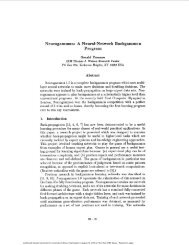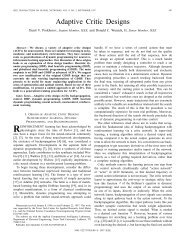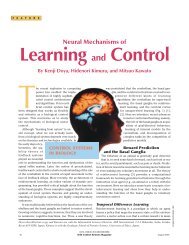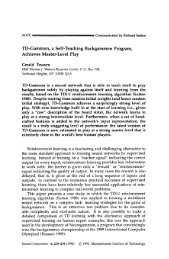Optimal Tracking Control for a Class of Nonlinear Discrete-Time ...
Optimal Tracking Control for a Class of Nonlinear Discrete-Time ...
Optimal Tracking Control for a Class of Nonlinear Discrete-Time ...
You also want an ePaper? Increase the reach of your titles
YUMPU automatically turns print PDFs into web optimized ePapers that Google loves.
ZHANG et al.: OPTIMAL TRACKING CONTROL FOR A CLASS OF NONLINEAR DISCRETE-TIME SYSTEMS WITH TIME DELAYS BASED ON HDP 1861VI. CONCLUSIONIn this paper, we proposed an effective HDP algorithmto solve optimal tracking problem <strong>for</strong> a class <strong>of</strong> nonlineardiscrete-time systems with time delays. First we defined aper<strong>for</strong>mance index <strong>for</strong> time delay systems. Then a novel iterationHDP algorithm has been developed to solve the optimaltracking control problem. Two neural networks have been usedto facilitate the implementation <strong>of</strong> the iteration algorithm.Simulation examples have demonstrated the effectiveness <strong>of</strong>the proposed optimal tracking control algorithm.REFERENCES[1] M. Z. Manu and J. Mohammad, <strong>Time</strong>-Delay Systems Analysis, Optimizationand Applications. New York: North-Holland, 1987.[2] D. H. Chyung, “On the controllability <strong>of</strong> linear systems with delay incontrol,” IEEE Trans. Autom. <strong>Control</strong>, vol. 15, no. 2, pp. 255–257, Apr.1972.[3] D. H. Chyung, “<strong>Control</strong>lability <strong>of</strong> linear systems with multiple delaysin control,” IEEE Trans. Autom. <strong>Control</strong>, vol. 15, no. 6, pp. 694–695,Dec. 1970.[4] H. Y. Shao and Q. L. Han, “New delay-dependent stability criteria<strong>for</strong> neural networks with two additive time-varying delay components,”IEEE Trans. Neural Netw., vol. 22, no. 5, pp. 812–818, May 2011.[5] J. P. Richard, “<strong>Time</strong>-delay systems: An overview <strong>of</strong> some recentadvances and open problems,” Automatica, vol. 39, no. 10, pp. 1667–1694, Oct. 2003.[6] S. C. Tong, Y. M. Li, and H. G. Zhang, “Adaptive neural networkdecentralized backstepping output-feedback control <strong>for</strong> nonlinear largescalesystems with time delays,” IEEE Trans. Neural Netw., vol. 22,no. 7, pp. 1073–1086, Jul. 2011.[7] V. N. Phat and H. Trinh, “Exponential stabilization <strong>of</strong> neural networkswith various activation functions and mixed time-varying delays,” IEEETrans. Neural Netw., vol. 21, no. 7, pp. 1180–1184, Jul. 2010.[8] Y. J. Liu, C. L. P. Chen, G.-X. Wen, and S. C. Tong, “Adaptive neuraloutput feedback tracking control <strong>for</strong> a class <strong>of</strong> uncertain discrete-timenonlinear systems,” IEEE Trans. Neural Netw., vol. 22, no. 7, pp. 1162–1167, Jul. 2011.[9] M. Wang, S. S. Ge, and K. S. Hong, “Approximation-based adaptivetracking control <strong>of</strong> pure-feedback nonlinear systems with multipleunknown time-varying delays,” IEEE Trans. Neural Netw., vol. 21,no. 11, pp. 1804–1816, Nov. 2010.[10] W. S. Chen and L. C. Jiao, “Adaptive tracking <strong>for</strong> periodically timevaryingand nonlinearly parameterized systems using multilayer neuralnetworks,” IEEE Trans. Neural Netw., vol. 21, no. 2, pp. 345–351, Feb.2010.[11] W. Y. Lan and J. Huang, “Neural-network-based approximate outputregulation <strong>of</strong> discrete-time nonlinear systems,” IEEE Trans. NeuralNetw., vol. 18, no. 4, pp. 1196–1208, Jul. 2007.[12] C. M. Zhang, G. Y. Tang, and S. Y. Han, “Approximate design <strong>of</strong>optimal tracking controller <strong>for</strong> systems with delayed state and control,”in Proc. IEEE Int. Conf. <strong>Control</strong> Autom., Christchurch, New Zealand,Dec. 2009, pp. 1168–1172.[13] Y. D. Zhao, G. Y. Tang, and C. Li, “<strong>Optimal</strong> output tracking control<strong>for</strong> nonlinear time-delay systems,” in Proc. 6th World Congr. Intell.<strong>Control</strong> Autom., Dalian, China, Jun. 2006, pp. 757–761.[14] Y. M. Park, M. S. Choi, and K. Y. Lee, “An optimal tracking neurocontroller<strong>for</strong> nonlinear dynamic systems,” IEEE Trans. Neural Netw.,vol. 7, no. 5, pp. 1009–1110, Sep. 1996.[15] J. Fu, H. B. He, and X. M. Zhou, “Adaptive learning and control <strong>for</strong>MIMO system based on adaptive dynamic programming,” IEEE Trans.Neural Netw., vol. 22, no. 7, pp. 1133–1148, Jul. 2011.[16] R. E. Bellman, Dynamic Programming. Princeton, NJ: Princeton Univ.Press, 1957.[17] P. J. Werbos, “A menu <strong>of</strong> designs <strong>for</strong> rein<strong>for</strong>cement learning over time,”in Neural Networks <strong>for</strong> <strong>Control</strong>, W. T. Miller, R. S. Sutton, and P. J.Werbos, Eds. Cambridge, MA: MIT Press, 1991, pp. 67–95.[18] A. Al-Tamimi, F. L. Lewis, and M. Abu-Khalaf, “Model-free Q-learningdesigns <strong>for</strong> linear discrete-time zero-sum games with application toH-infinity control,” Automatica, vol. 43, no. 3, pp. 473–481, Mar. 2007.[19] D. Vrabie, O. Pastravanu, M. Abu-Khalaf, and F. L. Lewis, “Adaptiveoptimal control <strong>for</strong> continuous-time linear systems based on policyiteration,” Automatica, vol. 45, no. 2, pp. 477–484, Feb. 2009.[20] K. G. Vamvoudakis and F. L. Lewis, “Online actor critic algorithm tosolve the continuous-time infinite horizon optimal control problem,”Automatica, vol. 46, no. 5, pp. 878–888, May 2010.[21] W. B. Powell, Approximate Dynamic Programming: Solving the Curses<strong>of</strong> Dimensionality. New York: Wiley, 2009.[22] C. Zheng and S. Jagannathan, “Generalized Hamilton–Jacobi–Bellman<strong>for</strong>mulation-based neural network control <strong>of</strong> affine nonlinear discretetimesystems,” IEEE Trans. Neural Netw., vol. 19, no. 1, pp. 90–106,Jan. 2008.[23] P. He and S. Jagannathan, “Rein<strong>for</strong>cement learning neural-networkbasedcontroller <strong>for</strong> nonlinear discrete-time systems with inputconstraints,” IEEE Trans. Syst., Man, Cybern., Part B: Cybern.,vol. 37, no. 2, pp. 425–436, Apr. 2007.[24] J. J. Murray, C. J. Cox, G. G. Lendaris, and R. Saeks, “Adaptivedynamic programming,” IEEE Trans. Syst., Man, Cybern., Part C:Appl. Rev., vol. 32, no. 2, pp. 140–153, May 2002.[25] B. H. Li and J. Si, “Approximate robust policy iteration using multilayerperceptron neural networks <strong>for</strong> discounted infinite-horizon Markovdecision processes with uncertain correlated transition matrices,” IEEETrans. Neural Netw., vol. 21, no. 8, pp. 1270–1280, Aug. 2010.[26] J. Si and Y. T. Wang, “Online learning control by association andrein<strong>for</strong>cement,” IEEE Trans. Neural Netw., vol. 12, no. 2, pp. 264–276,Mar. 2001.[27] R. Enns and J. Si, “Helicopter trimming and tracking control usingdirect neural dynamic programming,” IEEE Trans. Neural Netw.,vol. 14, no. 4, pp. 929–939, Jul. 2003.[28] F. Y. Wang, N. Jin, D. R. Liu, and Q. L. Wei, “Adaptive dynamicprogramming <strong>for</strong> finite-horizon optimal control <strong>of</strong> discrete-timenonlinear systems with ε-error bound,” IEEE Trans. Neural Netw.,vol. 22, no. 1, pp. 24–36, Jan. 2011.[29] H. G. Zhang, Q. L. Wei, and D. R. Liu, “An iterative adaptivedynamic programming method <strong>for</strong> solving a class <strong>of</strong> nonlinear zero-sumdifferential games,” Automatica, vol. 47, no. 1, pp. 207–214, Jan. 2011.[30] P. J. Werbos, “Approximate dynamic programming <strong>for</strong> real-time controland neural modeling,” in Handbook <strong>of</strong> Intelligent <strong>Control</strong>: Neural,Fuzzy, and Adaptive Approaches, D.A.WhiteandD.A.S<strong>of</strong>ge,Eds.New York: Van Nostrand, 1992, ch. 13.[31] J. Seiffertt, S. Sanyal, and D. C. Wunsch, “Hamilton–Jacobi–Bellmanequations and approximate dynamic programming on time scales,”IEEE Trans. Syst., Man, Cybern., Part B: Cybern., vol. 38, no. 4, pp.918–923, Aug. 2008.[32] Y. Zhao, S. D. Patek, and P. A. Beling, “Decentralized Bayesian searchusing approximate dynamic programming methods,” IEEE Trans. Syst.,Man, Cybern., Part B: Cybern., vol. 38, no. 4, pp. 970–975, Aug. 2008.[33] F. L. Lewis and D. Vrabie, “Rein<strong>for</strong>cement learning and adaptivedynamic programming <strong>for</strong> feedback control,” IEEE Circuits Syst. Mag.,vol. 9, no. 3, pp. 32–50, Sep. 2009.[34] F. Y. Wang, H. G. Zhang, and D. R. Liu, “Adaptive dynamicprogramming: An introduction,” IEEE Comput. Intell. Mag., vol. 4,no. 2, pp. 39–47, May 2009.[35] S. J. Bradtke, B. E. Ydestie, and A. G. Barto, “Adaptive linear quadraticcontrol using policy iteration,” in Proc. Amer. <strong>Control</strong> Conf., vol.3.Baltimore, MD, Jun. 1994, pp. 3475–3479.[36] A. Al-Tamimi, F. L. Lewis, and M. Abu-Khalaf, “<strong>Discrete</strong>-timenonlinear HJB solution using approximate dynamic programming:Convergence pro<strong>of</strong>,” IEEE Trans. Syst., Man, Cybern., Part B: Cybern.,vol. 38, no. 4, pp. 943–949, Aug. 2008.[37] H. G. Zhang, Q. L. Wei, and Y. H. Luo, “A novel infinite-time optimaltracking control scheme <strong>for</strong> a class <strong>of</strong> discrete-time nonlinear systemsvia the greedy HDP iteration algorithm,” IEEE Trans. Syst., Man,Cybern., Part B: Cybern., vol. 38, no. 4, pp. 937–942, Aug. 2008.[38] H. G. Zhang, Y. H. Luo, and D. R. Liu, “Neural-network-based nearoptimalcontrol <strong>for</strong> a class <strong>of</strong> discrete-time affine nonlinear systemswith control constraints,” IEEE Trans. Neural Netw., vol. 20, no. 9, pp.1490–1503, Sep. 2009.[39] A. Isidori, <strong>Nonlinear</strong> <strong>Control</strong> Systems II. New York: Springer-Verlag,2005.[40] S. B. Gershwin and D. H. Jacobson, “A controllability theory <strong>for</strong>nonlinear systems,” IEEE Trans. Autom. <strong>Control</strong>, vol. 16, no. 1, pp.37–46, Feb. 1971.[41] A. Bicchi, A. Marigo, and B. Piccoli, “On the reachability <strong>of</strong> quantizedcontrol systems,” IEEE Trans. Autom. <strong>Control</strong>, vol. 47, no. 4, pp.546–563, Apr. 2002.[42] A. Ben-Israel and T. N. E. Greville, Generalized Inverse: Theory andApplications, 2nd ed. New York: Springer-Verlag, 2002.









